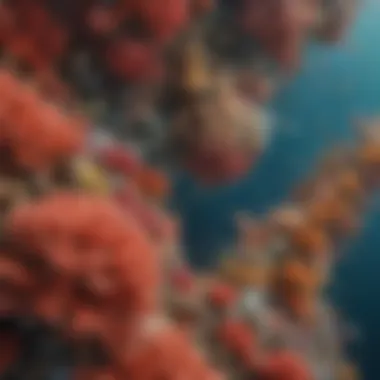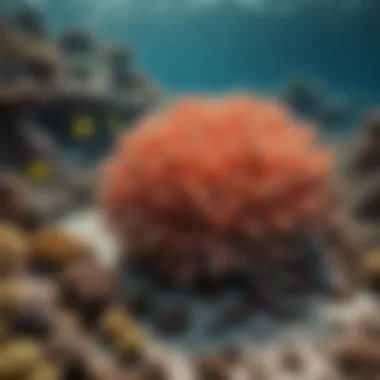Where is a Coral Reef: An In-Depth Examination


Intro
Coral reefs are some of the most vibrant ecosystems on our planet. They are often called the "rainforests of the sea" due to their diversity and abundance of life. However, their geographical locations and ecological significance often remain misunderstood.
This article seeks to clarify where coral reefs are found and examine their importance in marine environments. It will also address the numerous threats that face these critical habitats.
Through this exploration, readers will gain insight into the existing literature regarding coral reefs and their roles within broader ecological frameworks.
Let us begin by considering the research context, which provides a solid foundation for our inquiry into coral reefs.
Intro to Coral Reefs
Understanding coral reefs is essential for grasping their role in marine ecosystems. Coral reefs are not only beautiful but serve as vital habitats for numerous marine species. This section will introduce the reader to what coral reefs are and why they hold great ecological significance.
Definition of Coral Reefs
Coral reefs are underwater structures made primarily of calcium carbonate, produced by coral polyps. These small, soft-bodied organisms live in colonies and, over thousands of years, create these complex ecosystems. The intricate formations may vary in shapes and sizes, ranging from towering structures to delicate frameworks. They are primarily found in tropical and subtropical waters worldwide. Importantly, coral reefs are often referred to as the "rainforests of the sea", a designation that highlights their diversity though it can lack precision due to the unique natures of each ecosystem.
Importance of Coral Reefs
Coral reefs play an irreplaceable role in our oceans, providing numerous benefits:
- Biodiversity Hotspots: They are home to more than 25% of all marine species, despite covering only about 1% of the ocean floor. This biodiversity is crucial for ecological balance.
- Economic Contributions: Many communities rely on coral reefs for income through tourism and fishing. Reefs attract millions of divers and snorkelers annually.
- Coastal Protection: Coral reefs act as barriers, reducing the force of waves and protecting coastlines from erosion. This function is increasingly critical in the face of rising sea levels.
- Medicinal Resources: Many medical advancements have roots in marine organisms found in coral reefs, offering potential treatments for various diseases.
In sum, coral reefs are much more than mere formations; they are complex ecosystems with extensive implications for marine life and human activities. Their health is a global concern, shaping conservation efforts.
"Coral reefs are among the most biologically productive ecosystems on Earth, hosting a vast array of life forms that play essential roles in their environments."
This introduction lays the groundwork for a deeper exploration of their geographical distribution, types, and the challenges they face. We will delve into these aspects in the subsequent sections.
Geographical Distribution
Understanding the geographical distribution of coral reefs is essential for grasping their ecological significance. Coral reefs do not exist in isolation; their locations are determined by various factors that influence their development and sustainability. Their distribution is predominantly found in tropical and subtropical regions of the world, where water temperature, light penetration, and salinity create optimal conditions for coral growth. Identifying these locations helps in recognizing which areas are most vulnerable to environmental changes and human activities.
Tropical Regions
Tropical regions host the richest diversity of coral reefs, primarily located between the Tropic of Cancer and the Tropic of Capricorn. These areas are characterized by warm sea temperatures, typically between 23°C to 29°C, providing ideal conditions for coral polyps to thrive. Some notable examples of tropical coral reefs include:
- Great Barrier Reef in Australia
- Coral Triangle spanning Indonesia, Malaysia, and the Philippines
- Caribbean Sea with its various reef systems
The corals in these regions exhibit remarkable biodiversity. It is estimated that tropical reefs can contain up to 1 million different species. Such high biodiversity contributes to the resilience of these ecosystems, allowing them to recover from disturbances, such as storms and bleaching events.
Additionally, tropical reefs provide critical ecosystem services, such as coastal protection, fishery resources, and tourism. However, their geographical concentration also makes them susceptible to the impacts of climate change, which threatens their very existence. Monitoring their health is vital for conservation and management practices.
Subtropical Regions
Subtropical regions, while less biologically diverse than tropical areas, still support significant coral populations. These regions typically lie just outside the tropics, often experiencing cooler water but still favorable conditions for some coral species. Key locations of subtropical coral reefs include:
- Florida's Coral Reef
- Mediterranean Sea
- Red Sea


Coral species in subtropical waters often display different biological adaptations compared to their tropical counterparts. They might not require as much light and can tolerate slightly more fluctuating temperatures. Nonetheless, they are still vulnerable to stressors, such as ocean acidification and pollution, which can adversely affect their ability to thrive.
In summary, geographical distribution of coral reefs is critical for understanding their ecological roles and the challenges they face. Whether in the tropical or subtropical regions, preserving these delicate ecosystems requires a focused effort for monitoring, research, and conservation.
Types of Coral Reefs
Understanding the different types of coral reefs is crucial for grasping their ecological significance and the services they provide. Coral reefs form complex structures that are essential to marine biodiversity. This section will articulate the unique characteristics of fringing reefs, barrier reefs, and atolls, offering insights into their ecological functions and importance in marine environments.
Fringing Reefs
Fringing reefs are the most common type of coral reef, located close to shorelines. They grow directly from the ocean floor and extend to the land, creating a shallow lagoon between the reef and the shore. This proximity to land positions fringing reefs as vital coastal barriers. They protect shorelines from wave impact, reducing erosion and safeguarding coastal ecosystems.
- Biodiversity: Fringing reefs support a rich diversity of marine species. Their varied habitats offer shelter and food to numerous fish, invertebrates, and other marine organisms.
- Biological Role: These reefs play a critical role in the marine food web, serving as breeding grounds for many commercially important species.
- Human Benefits: Locally, fringing reefs deliver economic benefits through tourism and fishing. Coral reef tourism draws visitors for snorkeling and diving experiences, contributing to local economies.
Barrier Reefs
Barrier reefs are more extensive and lie further from shore compared to fringing reefs. They are separated from the coastline by deeper lagoons. The Great Barrier Reef off the coast of Australia is the most famous example. These structures are significant not only for their size but also for their intricate ecosystems.
- Environmental Functions: Barrier reefs moderate wave energy, thus providing a buffer against storm surges. This function is increasingly important given the rise in extreme weather events.
- Habitat Complexity: Composed of numerous areas like lagoons and channels, barrier reefs provide diverse habitats that further enhance biodiversity.
- Research Opportunities: Their complexity opens avenues for research in marine biology and ecosystem management. Studying barrier reefs can reveal the impacts of climate change and pollution on expansive marine systems.
Atolls
Atolls represent a captivating type of coral reef. Typically formed from the subsidence of volcanic islands, atolls consist of a ring-shaped coral reef encircling a lagoon. They are predominantly found in deeper oceanic regions. Atolls offer unique insights into evolutionary biology due to their isolation and distinct ecosystems.
- Ecosystem Isolation: Atolls serve as isolated ecosystems where unique species often evolve. This isolation can lead to high levels of endemism among marine organisms.
- Environmental Indicators: The health of atolls is indicative of wider oceanic and environmental conditions. They are sensitive to changes, making them effective indicators of climate change effects on marine environments.
- Cultural Significance: Many atolls support small populations that rely on fishing and tourism for their livelihoods. Their unique ecosystems provide both resources and cultural identity for these communities.
Generally, coral reefs provide critical ecosystem services that are vital for marine life and human economies.
In summary, each type of coral reef plays a pivotal role in maintaining marine biodiversity and supporting human activities. Recognizing their significance promotes conservation efforts aimed at preserving these valuable ecosystems.
Coral Reef Ecosystems
Coral reefs are not merely clusters of vibrant marine life. They represent a complex and interdependent ecosystem that supports a wide variety of species. Understanding coral reef ecosystems is essential to appreciating their ecological importance and the benefits they provide to marine environments.
Biodiversity in Coral Reefs
Coral reefs harbor exceptionally high levels of biodiversity, often described as the "rainforests of the sea." They are home to nearly 25% of all marine species despite covering less than 1% of the ocean’s surface. The intricate structures of coral reefs provide habitats for a diverse array of organisms, including fish, invertebrates, and algae.
Key factors contributing to this biodiversity include:
- Habitat Complexity: The three-dimensional frameworks of coral provide numerous niches for various species.
- Symbiotic Relationships: Many species engage in mutualistic relationships. For instance, clownfish live among anemones and provide protection, while anemones benefit from the waste produced by clownfish.
This biodiversity is crucial because it bolsters the resilience of coral reefs. Diverse ecosystems can adapt better to changes and recover from stressors like bleaching events.
Role in Marine Food Webs
Coral reefs play a pivotal role in marine food webs, acting as nursery grounds for many fish species. Small fish and invertebrates find shelter among corals, providing food for larger predators. The intricate interactions within this food web exemplify the balance that coral reefs maintain in ocean ecosystems.
Key roles include:
- Primary Producers: Algae, particularly zooxanthellae, provide energy through photosynthesis. This energy is crucial for the growth of coral.
- Predator-Prey Dynamics: Coral reefs support a range of predatory species, which helps regulate populations of smaller fish and invertebrates, maintaining a healthy balance.


In summary, coral reef ecosystems are complex networks that not only sustain vast biodiversity but also underlie critical marine food webs. Protecting these ecosystems is fundamental to preserving their myriad benefits for future generations.
"The continued survival of coral reefs is vital not only for marine life but also for human populations reliant on them for food, coastal protection, and tourism."
Geographic Locations of Major Coral Reefs
Understanding the geographic locations of major coral reefs is crucial because these areas are not only biological treasures but also have significant socio-economic implications. Coral reefs support vast numbers of marine species and play a pivotal role in coastal protection. Their locations in the tropics and subtropics impact marine biodiversity and ecosystem health. Additionally, identifying these regions helps in global conservation efforts, as many reefs face threats from climate change, pollution, and overfishing.
Great Barrier Reef
The Great Barrier Reef is the largest coral reef system in the world stretching over 2,300 kilometers along the northeast coast of Australia. It consists of approximately 2,900 individual reefs and 900 islands. The biodiversity hosted here is extraordinary, featuring over 1,500 species of fish and 400 species of coral. The reef is vital for both the environment and the economy of Australia; it supports tourism, fishing, and research. As a UNESCO World Heritage Site, it also symbolizes the need for conservation efforts due to its vulnerability to climate change and thermal stress.
Coral Triangle
The Coral Triangle is a marine area located in the western Pacific Ocean, defined by the waters of six countries: Indonesia, Malaysia, Papua New Guinea, the Philippines, Solomon Islands, and Timor-Leste. This region is known as the "Amazon of the Seas" because it contains the highest diversity of marine species on Earth, including 76% of all known coral species. The health of the Coral Triangle is critical for global marine biodiversity; it protects coastal communities and provides livelihoods for millions of people. However, it is increasingly threatened by unsustainable fishing practices and climate impacts.
Red Sea Coral Reef
The Red Sea Coral Reef is a significant coral ecosystem located in the Red Sea, bordered by Egypt, Sudan, Saudi Arabia, and Yemen. Home to over 400 species of coral, it exhibits remarkable resilience to high temperatures and salinity levels. This reef is a vital habitat for numerous marine organisms and contributes considerably to the local economies through fishing and tourism. However, it faces threats from port development, tourism activities, and changing ocean temperatures.
Caribbean Coral Reefs
Caribbean Coral Reefs are among the most diverse and ecologically vital systems in the marine realm. They stretch across several countries, including Cuba, the Bahamas, and the Dominican Republic. The Caribbean is known for its vibrant and diverse marine life; it provides essential services such as coastal protection and fishery resources. These ecosystems are heavily impacted by climate change, especially coral bleaching, which leads to significant declines in coral cover. Conservation efforts are vital to ensure the survival of these rich underwater environments.
"Coral reefs are not just the rainforest of the sea; they are vital for the health of our oceans and the well-being of coastal communities worldwide."
To conclude, the geographic locations of major coral reefs are a blend of natural beauty and ecological importance. Each specific reef, from the Great Barrier Reef to the Coral Triangle, holds unique ecosystems and contributes to marine diversity. Protecting these areas is essential for future generations and maintaining the health of our oceans.
Threats to Coral Reefs
Coral reefs, often deemed the rainforests of the sea, are facing multiple threats that compromise their health and existence. Understanding these threats is crucial as they not only impact marine biodiversity but also affect human societies dependent on these ecosystems for livelihood and protection. This section delves into three significant threats: climate change, pollution, and overfishing and habitat destruction.
Climate Change
Climate change represents one of the most pressing threats to coral reefs worldwide. Rising global temperatures cause ocean waters to warm, resulting in coral bleaching. This phenomenon occurs when corals expel the symbiotic algae, known as zooxanthellae, that live within their tissues. These algae provide corals with food, making their expulsion critical for the corals' survival. When bleached, corals become more susceptible to disease and mortality.
Additionally, increased levels of carbon dioxide lead to ocean acidification. Acidic waters reduce the availability of carbonate ions, which corals require to build their calcium carbonate skeletons. Without sufficient carbonate ions, coral growth is stunted, compromising the whole reef structure. The long-term implications of these changes are dire, affecting not only the reef itself but also the myriad of species that depend on it.
Pollution
Pollution is another major threat to coral reefs, with a variety of sources contributing to their decline. Agricultural runoff often introduces nutrients like nitrogen and phosphorus into marine environments. These nutrients can lead to harmful algal blooms, which block sunlight from reaching corals and deplete oxygen levels in the water. This creates hypoxic conditions, further threatening coral survival.
Moreover, plastic waste and marine debris can physically damage coral structures. Toxic substances found in many pollutants can accumulate in marine organisms, diminishing overall health and leading to declines in fish populations. Increased sedimentation from coastal development and deforestation can smother corals, making it difficult for them to thrive.
Overfishing and Habitat Destruction
Overfishing severely impacts the balance of coral reef ecosystems. Targeting key species, such as herbivorous fish, disrupts the natural processes that keep algal growth in check. A decrease in these fish populations may lead to algal overgrowth, suffocating corals and diminishing reef health.
Habitat destruction further exacerbates this issue. Coastal development for tourism, agriculture, and urbanization results in the destruction of essential habitats. Mangroves and seagrasses, important for reef health, are often removed, increasing sedimentation and nutrient runoff into the ocean. Such actions diminish the resilience of coral reefs to withstand other pressures.
In sum, addressing these threats is vital. Conservation efforts must focus on mitigating climate change impacts, reducing pollution, and implementing sustainable fishing practices. The survival of coral reefs relies not only on understanding these threats but also on global action to preserve these critical ecosystems.


Conservation Efforts
Conservation efforts play a crucial role in sustaining coral reef ecosystems, which are among the most biodiverse and economically important systems on the planet. As climate change, pollution, and human activities pose significant threats, the need for effective conservation strategies becomes increasingly urgent. These efforts not only aim to protect the natural environments but also to ensure that the resources and services provided by coral reefs are preserved for future generations.
Protected Marine Areas
One significant aspect of conservation efforts is the establishment of protected marine areas (PMAs). These designated zones restrict human activities to minimize ecological disturbances. By limiting access to sensitive regions, PMAs can help restore damaged ecosystems and provide a safe haven for various species. Successful examples include places like the Great Barrier Reef Marine Park in Australia, which limits fishing and tourism activities. This helps to enhance biodiversity and offers recovery opportunities for coral populations.
“Protected marine areas are essential for maintaining healthy ecosystems and empowering local communities.”
Sustainable Practices
Adopting sustainable practices is another key element in conservation. This approach involves implementing environmentally friendly methods in industries such as tourism, fishing, and agriculture. For instance, divers and tour operators can practice responsible tourism by following guidelines that reduce their ecological footprint. Likewise, fisheries can employ sustainable fishing techniques to ensure that fish populations remain stable. These practices collectively help mitigate harmful impacts on coral reefs and support the longevity of marine life.
Community Involvement
Community involvement is crucial for the success of conservation initiatives. Local populations often rely on coral reefs for their livelihoods, and their participation in conservation can lead to more effective management. Engaging communities in educational programs raises awareness about the importance of coral ecosystems and promotes stewardship. Volunteering for beach clean-ups or participating in reef restoration projects are examples of how community actions can lead to significant positive changes. Moreover, when communities are empowered, they are more likely to advocate for policies that protect their local marine environments.
In summary, conservation efforts addressing the protection of marine areas, the implementation of sustainable practices, and the involvement of local communities create a multifaceted approach to ensuring the future of coral reefs. Each element is interconnected, emphasizing that collective action is necessary for impactful conservation. The future health of coral reefs largely hinges on these ongoing and committed efforts.
Future of Coral Reefs
The future of coral reefs is critical for both marine ecosystems and human societies. Given their ecological significance, the health of coral reefs impacts biodiversity, fisheries, and coastal protection. Understanding what lies ahead for these complex systems involves examining various forms of resilience that corals may demonstrate in the face of ongoing challenges.
Coral reefs face immense pressures from climate change, pollution, and habitat destruction. However, they are not entirely without hope. Studies indicate that certain species of corals can adapt to changing conditions. This adaptability is essential for the survival of reefs that play a pivotal role in marine biodiversity.
Key Elements to Consider:
- Adaptation Mechanisms: Corals can exhibit physiological changes that enhance tolerance to stressors such as increased temperature and acidity. These mechanisms may include changes in symbiotic algae population, which are crucial for coral health.
- Genetic Diversity: Genetic variation among coral populations provides a reservoir of traits that may support resilience. Future conservation efforts will need to emphasize preserving this diversity.
- Restoration Efforts: Innovative techniques in coral farming and transplantation are being utilized. These techniques allow us to restore coral populations and damaged reefs effectively.
"Coral reefs are not just beautiful underwater sights but also vital ecosystems that require immediate attention for their preservation."
As we consider the future of coral reefs, it is also important to foster community involvement in conservation efforts. Engaging local communities can create shared responsibility for reef health. Education and awareness campaigns can equip these communities with the knowledge necessary to protect their local environments.
Adaptation and Resilience
Adaptation and resilience refer to the ability of coral reefs to withstand and recover from disturbances. Research shows that corals can adapt their biological processes to endure climate extremes. For instance, some species have developed mechanisms to tolerate higher temperatures.
Factors Influencing Adaptation:
- Species Selection: Different species of corals show varying levels of resilience to environmental stress. Choosing resilient species is vital for restoration projects.
- Habitat Connectivity: Healthy reef systems are often interconnected. This connectivity allows for the migration of species and genetic exchange, further supporting resilience.
- Conservation Strategies: Effective management strategies that include protecting marine areas and enforcing fishing regulations can enhance the resilience of coral reefs.
In summary, the future of coral reefs depends on a multilayered approach that combines adaptation, genetic diversity, community involvement, and effective conservation strategies. By considering these elements, we can help secure a more sustainable future for these essential ecosystems.
Culmination
The conclusion serves as a critical component of this article, encapsulating the essence of coral reefs' geographical distribution, ecological significance, and pressing threats. As one synthesizes the insights presented, it becomes evident that coral reefs are not merely beautiful marine formations; they are vital ecosystems that support a remarkable diversity of life. The importance of recognizing their value cannot be overstated, as they play a crucial role in maintaining marine biodiversity and providing essential resources for human communities.
Summary of Key Findings
Researchers and enthusiasts alike should note several key findings from this exploration:
- Geographical Plan: Coral reefs primarily thrive in tropical and subtropical regions, with notable locations including the Great Barrier Reef, Coral Triangle, and Caribbean reefs.
- Types of Reefs: Different types of coral reefs, including fringing reefs, barrier reefs, and atolls, emphasize the versatility and adaptability of coral structures.
- Ecosystem Role: Coral reefs act as hubs of marine biodiversity, supporting numerous species and contributing to global fish stocks.
- Threats: The threats posed by climate change, pollution, and human activities urge immediate attention. Rising sea temperatures, ocean acidification, and sedimentation lead to significant challenges for coral survival.
- Conservation Efforts: Effective conservation strategies, such as protected marine areas and sustainable practices, are crucial for preserving these ecosystems. Community involvement enhances conservation initiatives and fosters stewardship of marine resources.
"Coral reefs are a bellwether for the health of our ocean. Their decline signals broader ecological issues that must be addressed urgently."
By remaining informed about the status of coral reefs and actively participating in conservation efforts, we can contribute to the vitality of these essential marine habitats.



